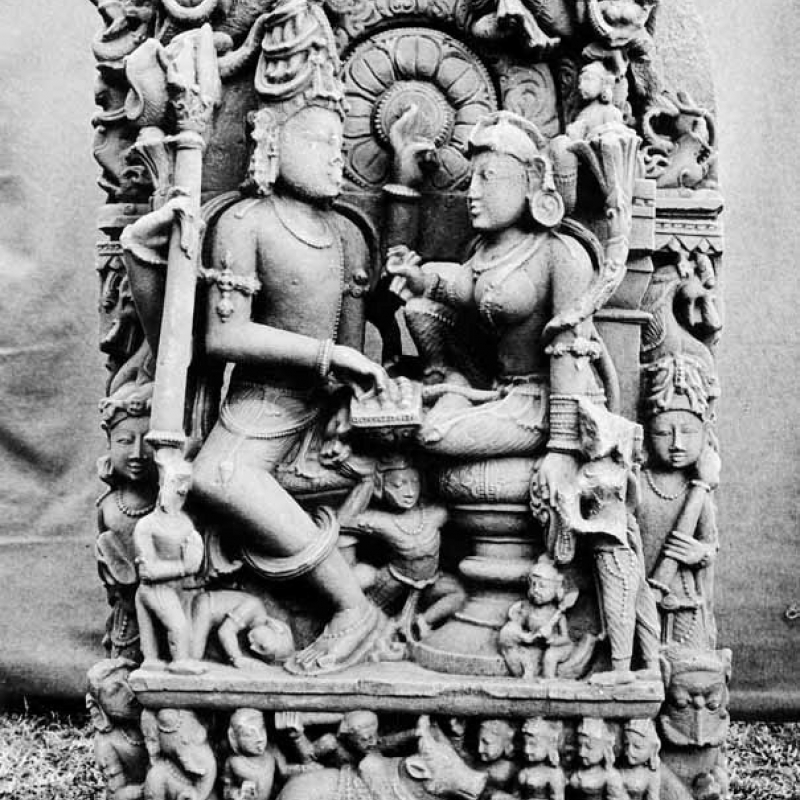One of the unexpected wonders of the Fatehpur Sikri complex built by Akbar in the 16th century is the Pachisi Courtyard. (Fig.1) As the engravings on the brick floor fade, this large outdoor area—eclipsed by a fort compound on one side and a lavish green garden on the other—escapes the attention of the unsuspecting tourist.
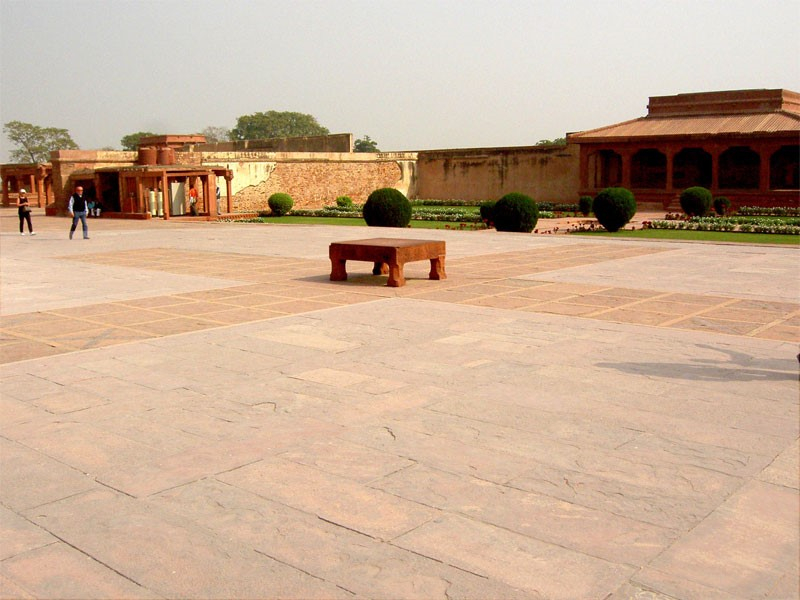
Abu’l Fazl, court historian of Akbar, tells us that during festivals this area would be used as a giant outdoor board for playing pachisi. Another legend has it that courtesans dressed in different colours acted as pieces of the game, leaping from box to box as their ruler rolled the dice sitting at the centre.
Regardless of which narrative is true, it is undeniable that the game of pachisi (often called chaupar, its close cognate) had an important place in the life of the imperial court. Abu’l Fazl diligently informs us how pachisi matches would go on for days, and the emperor would often mete out punishment to anyone who displayed even the slightest tedium or uneasiness with the game.[1]
Board games like pachisi, chaturanga, backgammon and gyan chaupar were important to various court cultures throughout India. In fact, Indian board games were in high demand in other imperial courts of the world too. The incident of Indian ambassadors presenting chaturanga to Khusrow I, King of Persia, finds mention in various Persian manuscripts. (Fig. 2)
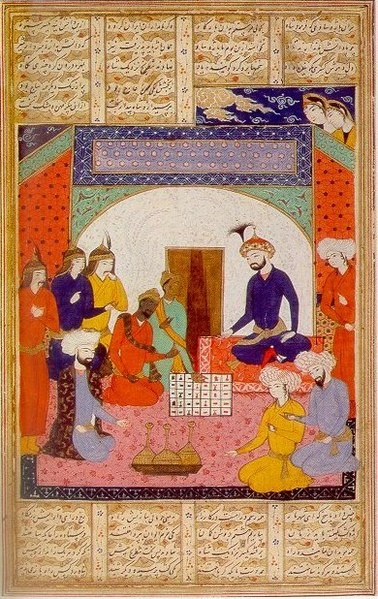
But board games have been a vital part of life outside the court as well. Many game traditions transcended the boundaries of the court and entered the lives of ordinary folk. Throughout the history of the subcontinent, they appear not only in court paintings but also in temple sculptures, epics and literary traditions. Indeed, it may not be wrong to say that understanding or developing a history of board games is akin to understanding various levels of Indian society in one broad sweep.
A Brief History: Board Games and Their Movements
Some of the earliest evidences of board games come from Indus Valley Civilisation in the form of archeological finds. The exact nature of the game and their rules are difficult to ascertain. Some scholars, like Irving Finkel, have to study the nature and rules of such games by looking at contemporaneous board games from Sumeria (like the famous game of Ur) about which a fair bit is known.[2] It is also clearly evident that gambling was a widespread activity in the Vedic period. Several hymns in the Rig Veda attest to this, most popular among them being a ‘Gamester’s Lament’.[3]
Study of this period gives us some ideas about the materials used in the games, even if they do not tell us much about the rules of the games played then. It seems that during this period, use of long rectangular dice, apart from the popular cubic dice, was widespread. Cowry shells came into the picture much later and became a popular choice, especially among the common people. Sources and evidences in the study of board games become more accessible as we approach the middle of the first millennium, the period of development of the games like chaupar and backgammon.
Backgammon
Backgammon seems to have emerged around the early Gupta period. Micaela Soar extensively surveyed extant archeological evidences to conclude that the early Indian form of backgammon emerged around 400 CE from the Punjab region and became the characteristic 2 x 12 row board game of backgammon.[4] This ancient board game was popular throughout the Indian subcontinent before it completely vanished from most textual and scriptural sources by the end of the first millennium. At the height of its popularity, it found representation in the art and culture of the time, famously as the game of Shiva and Parvati at various temples in the Ellora caves. (Fig. 3) Interestingly enough, backgammon moved out of India, towards Persia, by the end of the first millennium before being brought back as a Persian game in the Deccan in the medieval period by Mughals and various Sultanates.[5]
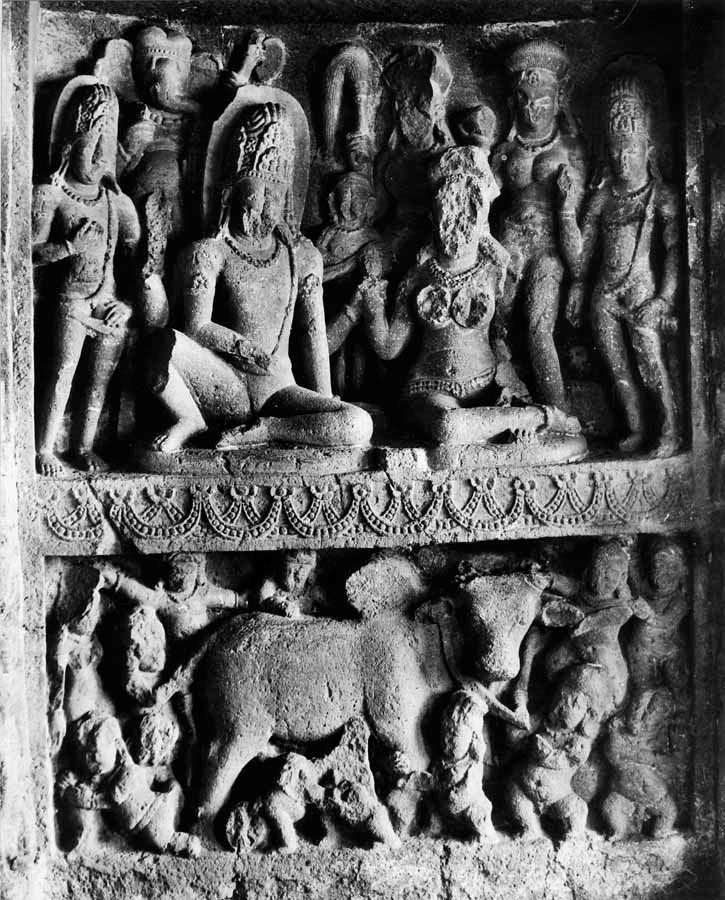
Chaupar
Chaupar (or pachisi) has an even more interesting timeline. It reached its high point during the Mughal period (as attested by the giant outdoor game board built by Akbar). It is also the game that most traditions ascribe to the downfall of Yudishthira in the Mahabharata.
Various forms of chaupar have flourished in India. The most modern version of this game is ludo, which was reintroduced in India by the British around 1950. Many commercial versions of Indian chaupar were extremely popular in the US in the twentieth century. (Fig. 4)
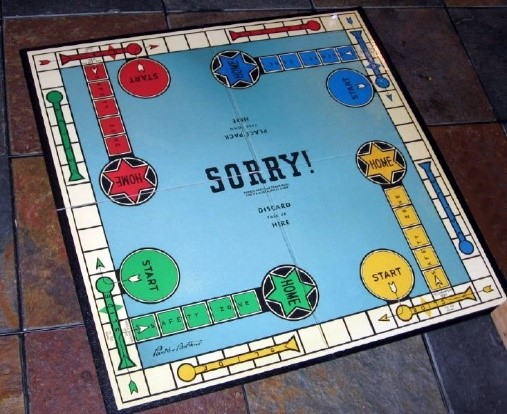
Gyan chaupar
The race game gyan chaupar also has a similar history. It was probably invented by Jain monks as a didactic game in the early part of the second millennium and later adopted by Hindu and Sufi traditions throughout the centuries of assimilation during the Bhakti period. However, it was reintroduced in India as the British game of snakes and ladders from the twentieth century onwards.
Chaturanga
Chaturanga was one of the more popular aristocratic games of ancient India. Developing around the sixth century CE, it started off as a didactic game to teach young princes about the four angas (parts) of the royal army: the infantry, the elephants, the chariot and the cavalry. The game was invented in India before being introduced to the West Asians, who took it to Europe from where chess, its most modern version, emerged.
The word chaturanga first appeared in the Mahabharata and Ramayana. This immensely popular game has undergone various changes from chaturanga to shatranj to finally chess.(Fig. 5)
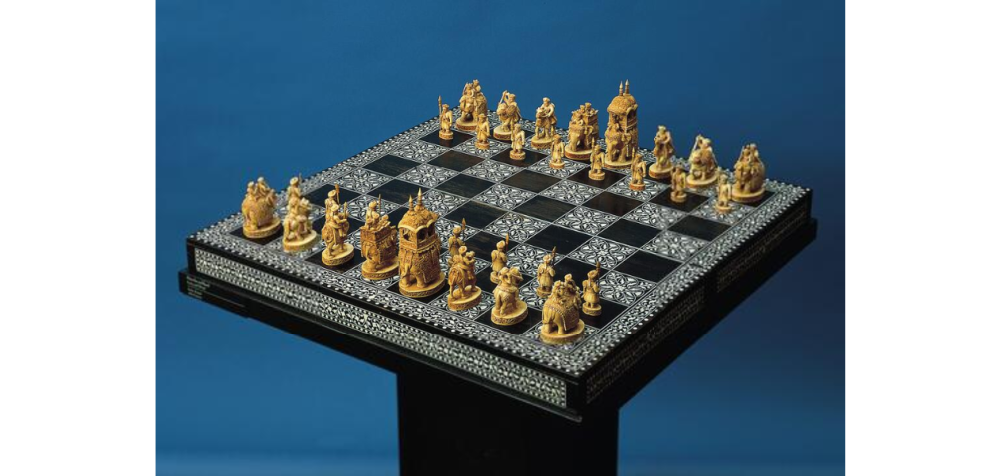
Most of the extant game boards that have been recovered come from the seventeenth century onwards. Therefore, histories of games that remained popular till then are easier to construct than others. In this respect, the efforts of Maharaja Krishnaraja Wodeyar III of Mysore (1794–1868) have been exemplary. A man of great cultural refinement and a board game enthusiast himself, he went to great lengths to help document and collect various folk board game traditions of India, resulting in long encyclopedias on the subject. For any ancient games enthusiast in South Asia, his collection is a treasure trove yet to be understood and written about. Scholars have only recently started going through his collections and have discovered various new aspects of South Indian games.[6]
Let us now look at the various cultural contexts in which these games come up and the roles they serve in their respective economy of meanings and symbols. First, we investigate the notion of the divine that occurs in various board games and its attendant representational forms.
The Divine Play
The question of the divine has always preceded the question of play and pleasure in ancient India. Numerous strands of Hindu philosophy fashion the world as an endless form of maya or illusion, highlighting the perpetual nature of the divine play or lila. As such, understanding the divine through its representations in traditions of ancient Indian board games becomes crucial.
Shiva and Parvati
One of the most enduring motifs throughout Indian art has been Shiva and Parvati playing a game of dice. One such relief from Maihar, Madhya Pradesh, portrays Shiva and Parvati playing the game. (Fig. 6) One can see Parvati is holding a dice in her hand and is about to play. This is an important theme, particularly in the cave temples of western Maharashtra where such ‘scenes appear in prominent position in relation to the central shrine’.[7] There was some confusion around the type of the board game they are shown playing but recently it has been identified as backgammon.[8]
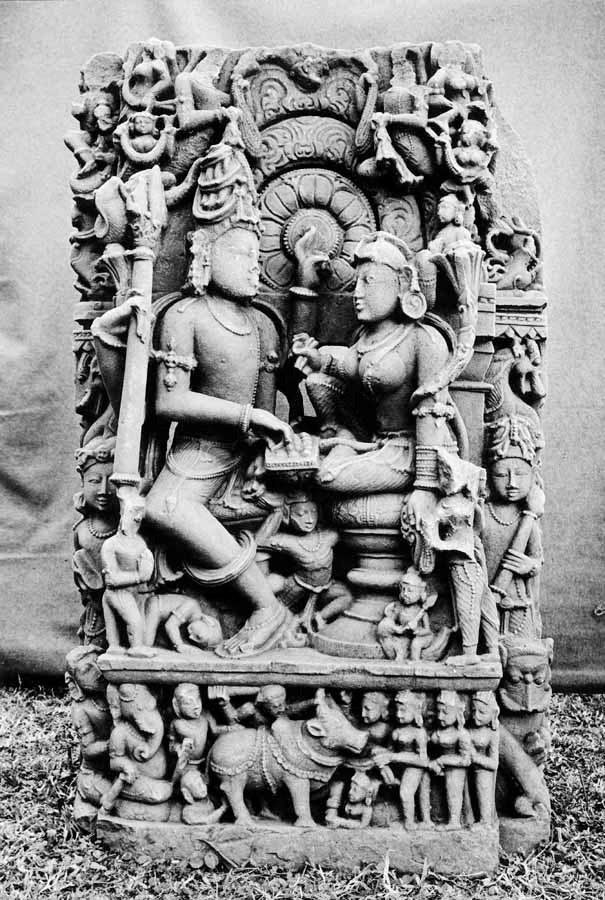
The Puranic tradition insists that the entire world is created as a result of this divine play between Shiva and Parvati, representing Purusha and Prakriti, with each move of the players mirroring different states of the world, potential or realised. The popular Kashikhanda episode of the Skanda Purana attests thus[9]:
O God of Gods, your game is the whole universe
The houses on the gaming board, O Lord, are the twelve months,
The dark and light pieces are the days of the moon,
Of which there are twice fifteen in month, the two dice are two paths of the sun
The two outcomes, victory and defeat, are called Creation and Dissolution.
When Devi wins there is Emanation,
When Dhurjati (Shiva) wins there is Reabsorption.
The game described in some detail in the passage above is the ancient game of backgammon. (Fig. 7) The obsessive play of Shiva and Parvati often results in Shiva putting at stake (and subsequently losing) everything and causing a lot of divine commotion (such as the birth of the demon Andhaka). In some traditions (particularly, eastern Indian sculptures), Shiva is shown as always losing to Parvati. This recurrent loss of Shiva to Parvati has led some scholars to wonder, ‘Why does Shiva play? Why does this god keep slipping into the game of dice, knowing, as he seems to, that he will almost certainly lose, and that other destructive consequences will flow from this defeat?’[10]
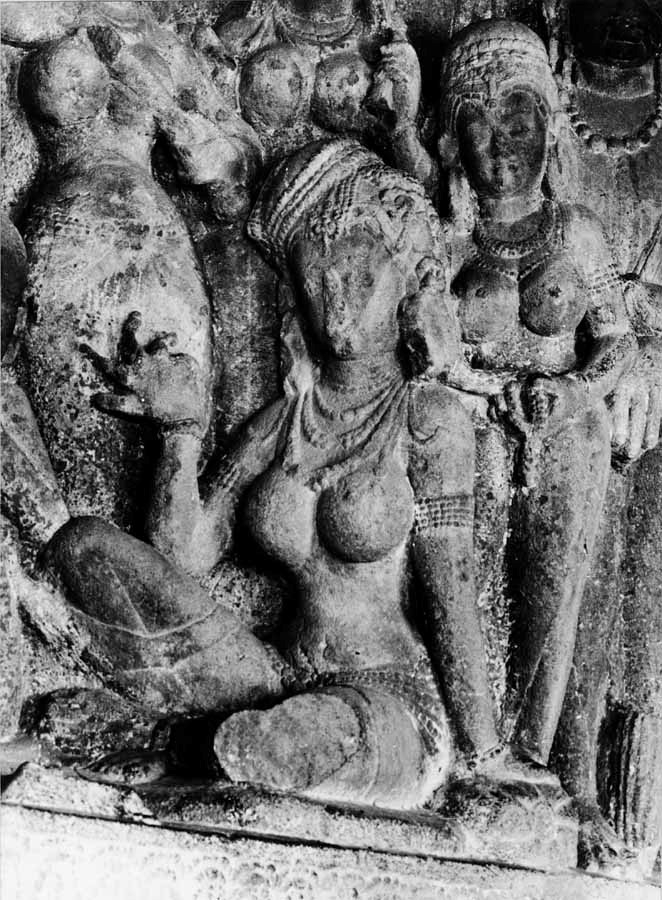
This question leads Shulman and Handelman, through their reading of Indian sculptures in cave temples and various religious texts, to conclude that fundamental notions of ‘asceticism, so frequently associated with Shiva, with Yoga, and with Hindu religion as a whole, are in fact foreign to its inherent logic.’ They alternatively suggest the primacy of ‘play of Shiva’ as being the cornerstone of the Hindu view of the world. Here, games understood as ‘forms of excesses, spilling over, self-extrusion’ transform the entire Hindu faith.[11]
Such theories illustrate what reading innocuous-seeming board games can do for us. Reading board games culturally can illuminate lost traditions, highlight alternative ways of understanding religion and, above all, provide us a route to a complex cultural past.
Gyan Chaupar and Shortcuts to Heaven
Board games were not simply meant as a pleasurable pastime, they were also intended for didactic purposes. The game of snakes and ladders, one of the most popular board games promoted by the British around the world, was originally conceived as an edifying game. The game is imbued with moral exhortation and imagery. Players are asked to play along the board and as they stumble upon virtues—‘faith’, ‘kindness’ or ‘forgiveness’—they leap ahead, climbing ladders; if they land on vices— ‘cruelty’, ‘avarice’ or ‘pride’—they are bitten by snakes which makes them fall down the numbers. This seemed to be the modular form of the snakes and ladders popular throughout the twentieth century, which was later made plain and simple, devoid of all the moralising (such as the versions we are more familiar with).
The game of snakes and ladders is the British version of the old Indian game, gyan chaupar. The Indian game has variety of versions spread across various parts of India and Nepal. A typical gyan chaupar game would consist of labelled boxes, which would indicate the states of being a player inhabits; the role of snakes is to punish players for vices, and the role of the ladders is to reward virtues.
The common thread unifying these board games was the moral injunction they sought to inculcate. Gyan chaupar also reveals the most elaborate and consistent doctrinal systems of karmic classification, part of Vaishnava or Jain philosophy. The movement of the players across the board game mirrors their movement from lower ways of being to progressively higher states, specific ascents of soul as also the relative seriousness of vices one can commit as indicated by the length of the snakes and the descent they cause a player.
In a similar vein, a lot of Bhakti literature also uses the metaphor of board games to highlight its central problems and solutions to them. For one such instance, sample this Kabir hymn[12]:
The Chaupar is spread out at the crossroads
In the midst of the up and down bazaar:
With Satguru as your partner,
You will never lose the game!
In the above hymn, we can see how the imagery of the game of chaupur is being used to refer to the confusing world (crossroads is an allusion to the four sides of chaupar game board). And the way out of this confusing world is the divine guru. Many such verses exist throughout the canonical texts that ostensibly use the metaphor repeatedly—of the world as a board game and players as humans thrust into this game. All these literary allusions depict the everydayness of board games in Indian life and the role they must have commanded in the cultural memory of communities.
The Games and Their Excess
The previous section highlighted the creative potential of ancient board games, their ability to transform human lives and values. We analysed the cultural context whereby the game of dice by Shiva gave life to Hinduism in one such reading of the game, and also how gyan chaupar helped in the instruction of various precepts of Vaishnava and Jain karmic philosophy. This section will move away from looking at the creative and the inspiring in traditional board games to analysing their destructive and catastrophic potential. We investigate this by looking at the cultural moments when these games become excessive or obsessive for their players. What do our epics, histories, narratives say happens when these games are played in their excess?
This question is important because the cultural record of traditional board games is just as much a history of celebration and carnival as it is a history of proscription and injunctions prohibiting it. For instance, the third-century Kamasutra of Vastsyayana lists skill at dice and other related games among the 64 polite arts of a human being, while Jain and Buddhist texts and the Manusmriti completely dismiss board games as frivolities and prohibit them.
The most obvious reminder of the ill effects of such games in the cultural memory of the subcontinent comes from the Mahabharata, where the young prince Yudhishthira loses it all because of his indulgent desire to keep on playing despite repeated warnings by his well-wishers. The exact game played between the two warring factions—Kauravas and Pandavas—is generally depicted to be chaupar but sometimes it is backgammon as well. The game is usually depicted as chaupar in Rajput paintings. However, in some renditions such as in versions of the Nepalese Mahabharata, the game depicted is backgammon.
In the Mahabharata, the board game sets in motion an epoch-making chain of events; thus, the board game and what it highlights about human nature is so central to the narrative of the epic. Along with Yudishthira, Nala, a minor character in the Mahabharata, also loses his wife in the course of a board game. This motif of characters being lost in game is continued to literature and art of our times. Another memorable rendering along the same theme is the famous Prem Chand novel Shatranj Ke Khiladi which, Topsfield writes, ‘satirises the escapist ethos of 19th century Lucknow, and its obliviousness to the greater political game being played out by the British in their moves to annex the kingdom.’ He adds, ‘It was time of Wajid Ali Shah. Lucknow was plunged in pleasures. The young and the old, the poor and the rich were all pleasure-bent. There was among people a passion for chess-board and playing cards.’[13] In more recent times, M.F. Hussain adopted the theme in his famous painting of the same name. Here, the game of chess becomes a symbol of general decay and decline of the Indian society.
In conclusion, through their various movements across dispersed contexts, board games have come to play an important role in illustrating a historical narrative of our past. We have seen how they help us understand religion, philosophy, and the myriad movements of powers across Asia and Europe. These factors necessitate a project to construct a cultural history of board games. Hopefully, in times to come, art historians will pay more attention to these artefacts of ancient India.
Notes
[1] Blochmann, The Ain-i Akbari of Abu'l Fazl Allami.
[2] Finkel, ‘The World Conqueror Emerges.’
[3] Topsfield, ‘Dice, Chaupar and Chess.’
[4] Soar, ‘Board Games and Backgammon in Ancient Indian Sculpture.’
[5] Ibid.
[6] Rangachar, Mahārāja's Games and Puzzles.
[7] Soar, ‘Board Games and Backgammon in Ancient Indian Sculpture.’
[8] Ibid.
[9] Handelmann and Shulman, God Inside Out.
[10] Ibid.
[11] Ibid.
[12] Kabir and Vaudeville, Kabir.
[13] Topsfield, ‘Dice, Chaupar and Chess.’
Bibliography
Vaudeville, C. Kabir Volume 1 (trans.). Oxford University Press, 1974.
Blochmann, H. The Ain-i Akbari of Abu'l Fazl Allami, vol. 1. Calcutta: Pranava Books, 1873.
Finkel, I.L. ‘The World Conqueror Emerges: Backgammon in Persia.’ In Asian Games: The Art of Conquest, edited by C. Mackenzie and I. Finkel. New York: Asia Society, 2004.
Rangachar, V. Mahārāja's Games and Puzzles. Kelheim: Foerderkreis Schach-Geschichtsforschung, 2006.
Shulman, D., and D. Handelman. God Inside Out : Siva's Game of Dice. New York: Oxford University Press, 1997.
Soar, M. ‘Board Games and Backgammon in Ancient Indian Sculpture.’ Ancient Board Games in Perspective: Papers from British Museum Colloquium with Additional Contributions, edited by I.L. Finkel, 177–231. London: British Museum Press, 2007.
Topsfield, Andrew. ‘Dice, Chaupar and Chess: Indian Games in History, Myth, Poetry.’ In The Art of Play: Board and Card Games of India, edited by A. Topsfield, 11–31. Mumbai: Marg Publishers, 2006.
———. ‘The Indian Game of Snakes and Ladders.’ Artibus Asiae 46, no. 3 (1985): 203–26.
